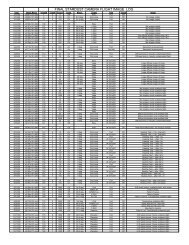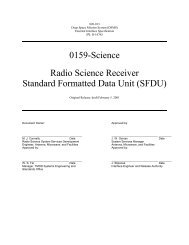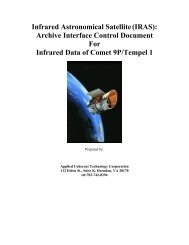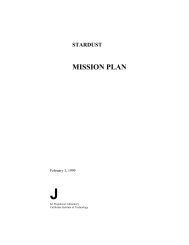The Scarlet Solar Array - PDS Small Bodies Node
The Scarlet Solar Array - PDS Small Bodies Node
The Scarlet Solar Array - PDS Small Bodies Node
- No tags were found...
Create successful ePaper yourself
Turn your PDF publications into a flip-book with our unique Google optimized e-Paper software.
DS1 <strong>Scarlet</strong> Technology Validation Page 18<br />
A summary depiction of the flight data against the<br />
forecasts for power, peak power voltage, and temperature<br />
is shown in Figure 25. <strong>The</strong> flight data is summarized by<br />
month in charts in Appendix B. Hourly data is depicted<br />
for voltage, wing currents, and RTD temperatures<br />
(averaged for each of the four positions in module).<br />
Max Power (W/100), Temp (C)<br />
80.00<br />
70.00<br />
60.00<br />
50.00<br />
40.00<br />
30.00<br />
20.00<br />
RTD Near Cell<br />
at Low Power Draw<br />
Voltage at Pmax<br />
10.00<br />
0.75<br />
0 20 40 60 80 100 120 140 160 180 200 220<br />
Mission Day<br />
Maximum Power<br />
Sun Distance<br />
Figure 25. Original Forecasts and Flight Data<br />
4. TECHNOLOGY VALIDATION SUMMARY<br />
On DS1, the first mission of NASA’s New Millennium<br />
Program, the <strong>Scarlet</strong> array has provided power as<br />
designed, over 2.5-kW at nominally 90 volts, to power the<br />
NSTAR ion propulsion engine, plus spacecraft bus loads,<br />
on the interplanetary mission.<br />
<strong>The</strong> accomplishments of the entire DS1 <strong>Scarlet</strong> program,<br />
in summary, were:<br />
• Development, manufacture and successful<br />
spacecraft integration of a novel advanced,<br />
multi-junction-cell-based, high voltage concentrator<br />
solar array;<br />
• Flight validation of new structural, mechanical,<br />
optical and electrical systems;<br />
• Flight validation of the modeling and predictions<br />
for power output;<br />
• Successful operation of the concentrator system<br />
on the DS1 spacecraft.<br />
<strong>The</strong>se accomplishments were achieved over 3 phases:<br />
Pre-flight: design, fabrication, test and integration,<br />
Launch and initial deployment, and the initial cruise<br />
phase of the mission. <strong>The</strong> specific successes of the<br />
<strong>Scarlet</strong> technology achieved on DS1 were:<br />
• Demonstration of novel technology<br />
1.35<br />
1.25<br />
1.15<br />
1.05<br />
0.95<br />
0.85<br />
Heliocentric Distance (AU), Voltage (V/100)<br />
ü<br />
<strong>The</strong> first successful concentrator array<br />
system in space<br />
• Utilizing the most advanced solar cell<br />
technology<br />
ü <strong>The</strong> first successful array system in space to<br />
use dual and triple junction solar cells<br />
• Demonstrating high specific power<br />
ü <strong>The</strong> first successful array system in space to<br />
use dual and triple junction solar cells<br />
• Demonstrating structural robustness<br />
ü <strong>The</strong> system stowed and deployed stiffness<br />
performance is excellent<br />
• Being designed for producibility<br />
ü This will allow for low recurring cost on<br />
future applications<br />
• Supporting all DS1 mission requirements<br />
ü <strong>The</strong> array performance provided the power<br />
needed to reach the encounter targets<br />
<strong>The</strong> risks that are inherent in the creation of such new<br />
technology are numerous and complex. A large portion<br />
of risk retirement was completed with thorough ground<br />
tests, but many elements of the technology simply<br />
couldn't be validated without the success of the launch,<br />
deployment, and the subsequent flight operations<br />
performed by JPL. <strong>The</strong> areas of highest remaining risk<br />
prior to launch were:<br />
• Structural or electrical damage during launch<br />
Broken lenses, loose wires or cracked cells<br />
Insufficient tiedown preload<br />
• Deploying successfully in zero gravity<br />
Imbalance from thermal loading<br />
Cable loads<br />
Hingeline binding<br />
Mechanism torque margin<br />
<strong>Array</strong> jump -out loading<br />
Damper failure due to deadband<br />
Panel insert strength margin<br />
Failure of the lens frame to deploy<br />
• Proper alignment to the sun<br />
Shifts in mountings from launch loads<br />
SC to array mounting accuracy<br />
Gimbal pointing accuracy<br />
Hinge stop adjustment<br />
<strong>The</strong>rmal warping<br />
Warping of the power panels and/or lens panels<br />
Moisture outgas shape change in composites<br />
Alignment of module elements<br />
Cells on carrier, carrier on substrate<br />
Lens panel over substrate






